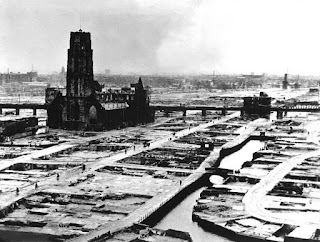Rotterdam--a historic city, home to the famed Erasmus and to centuries of European culture.
In one-hundred-twenty short hours, the city center was leveled, its visual history perishing in a past found only in paintings such as the above.
A downtown zoo, its property filled with animals, likewise tore apart. As people gazed out their windows, they noticed zoo animals floating down the canals. Some reported a lion walking through the streets. Others claimed to have spotted other zoo creatures meandering through the desolate city.
Today, a metal zebra emerging from a wire nest sits atop a pole on a street corner in Rotterdam, an artistic rendering commemorating those destructive days.
As a city, Rotterdam chose to redefine its space, innovating new structures and unique architectural designs after World War II. Since many of the pre-war edifices had been damaged or burned, city planners defined territory by demolishing much of the old architecture and rebuilding a new city from the rubble. Looking for a place with historic Dutch buildings? Rotterdam isn’t it.
One unique aspect of Rotterdam’s new architecture is cube housing, designed by a Dutch architect in the 1970s. Today, these quaint homes function in a variety of ways. For some, they even serve as an Air B and B location.
In the Bible, King Solomon compares the tongue to that which builds or destroys. Proverbs 18:21 states, "Death and life are in the power of the tongue: and they that love [life] shall eat the fruit thereof."
Wisdom directs God's children to choose edifying words that will encourage and build up those around them in the things of God. Ephesians 4:29 states, "Let no corrupt communication proceed out of your mouth, but that which is good to the use of edifying, that it may minister grace unto the hearers."
The clear opposite of building up is tearing down.
As the Nazi destroyers quickly bombed the heart of the old city of Rotterdam, leaving fires in the wake of the devastation and severely damaging the centuries-old architecture, the ill-advised tongue causes dissension, crafts caustic wounds, or spews bitter complaints. At some point, all that is left is smoldering ruins which must be rebuilt. Similar to how displaced animals testified to destruction, wounded spirits of broken people attest to the devastation caused by the unwise use of the tongue.
As Rotterdam’s post-war city planners created a new city from the devastated old one, the lips of wisdom edify others with words that encourage and energize. Rotterdam’s unique architectural structures remind us that, even if devastation and destruction have occurred from our speech, we can find victory by having a heart that chooses edification. Only God, the Wise Master Builder, can craft such a heart for us.
And then Magnificent architectural masterpieces of God’s love, ministered to others through our tongues, can result.
Photo Credits
https://www.warhistoryonline.com/world-war-ii/8-things-need-know-1940-rotterdam-terror-bombing-x.html?safari=1




Comments